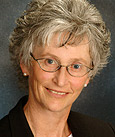
Jennifer Francis, research professor at the Institute of Marine and Coastal Sciences at Rutgers University in New Jersey.
The just-released IPCC report summarizing progress in climate science over the past six years reaffirms the messages delivered in previous reports, but with more certainty, more urgency, more clarity, and more specificity. Bottom line: the Earth is warming and changing, and humans are causing it. In my view, the most noteworthy aspect of the report is the consistency of the trends — not only in the ever-mounting evidence of changes in the climate system, but also in the increasing confidence of the statements about human contributions to those changes. The report should evaporate any remaining doubt about the reality, causality, and severity of the issue. This consensus of the world’s most esteemed scientists should part the clouds of disinformation perpetrated by those who stand to lose as we shift away from our fossil fuel-based energy infrastructure, and help the public see clearly through the smoke screen.

Michael Mann, distinguished professor of meteorology and director of the Earth System Science Center at Pennsylvania State University.
In many respects the panel has been overly conservative in its assessment of the science. The new report, for example, slightly reduces the lower end of the estimated uncertainty range for the amount of warming scientists expect in response to a doubling of CO2 concentrations compared to preindustrial levels. The lowering is based on one narrow line of evidence: the slowing of atmospheric warming during the past decade. Yet there are numerous explanations for this — including natural variability in the amount of heat absorbed by the ocean — that do not imply a lower sensitivity of the climate to greenhouse gases. The working group’s approach to global sea level rise is similarly conservative. The report gives an upper limit of roughly 1 meter of sea-level rise by the end of the century under business-as-usual carbon emissions, but credible, peer-reviewed research forecasts nearly twice that amount. As for the “hockey stick” graph that my colleagues and I devised — showing a sharp spike in warming in recent decades — the physical sciences working group report has actually strengthened its conclusions regarding the exceptional nature of modern warmth. The new report shows that there is now a veritable hockey league of reconstructions that not only confirms, but extends, the original hockey stick conclusions. The message of the latest IPCC report is clear: Climate change is real and caused by humans, and we will see far more dangerous and potentially irreversible impacts if we do not reduce global carbon emissions. There has never been a greater urgency to act than there is now.

Jane C.S. Long, chairman, California’s Energy Future Study, The California Council on Science and Technology.
The recent IPCC report sounds an incrementally more strident alarm about the dangers of increasing greenhouse gases in the atmosphere. The current policy response to this information does not reflect the dangers, urgency, or the quality of the information. At the same time, this IPCC report did not produce a more precise understanding of the impact of CO2 doubling. The range of probable outcomes was actually increased. It is ironic to think we could pick an emissions cap that will control the temperature increase to precisely 2 degrees C when years of study have resulted in decreasing the precision of the estimation of future temperature. The world is dithering over incremental emission caps that offer no guarantee of producing the result they have agreed on. Both policy and the IPCC should change course: More of the same is not likely to improve the response to climate change. More strategic approaches might help. The focus should change from bulky, comprehensive studies to deeper, more facile efforts targeted at phenomena and impacts that are poorly understood and could become critical. Feedback mechanisms, the role of aerosols and clouds, sea level rise, droughts, floods, and heat waves, etc., all deserve focused attention and the most up-to-date assessment. Such studies can shine a light on what keeps climate scientists up at night and hopefully keep the politicians awake as well. Second, the currently failing strategy of negotiating incremental emission caps should be replaced with a strategy for reinventing the energy system without emissions as fast as possible. Every region should create strategic plans for eliminating emissions as fast as they can. The IPCC can support this with alternative regional strategies for eliminating emissions.

Mark Pagani, professor and director of the Yale Climate and Energy Institute.
Details of the working group summary are not surprising, but two notable items come to mind. Equilibrium climate sensitivity to a doubling of CO2 has returned to the range cited in the IPCC Third Assessment Report, which is the same as in the first assessment of CO2 and climate chaired by Jules Charney in 1979. The “new” lower limit of 1.5 degrees C per CO2 doubling (from roughly 2 degrees C in the fourth assessment) apparently gives some folks ammunition to call it a “retreat.” But 1.5 degrees C is not compatible with actual Earth climate history for the recent past. If the globe has warmed 0.85 degrees C with a 40 percent increase in CO2 since preindustrial times, we have already experienced a sensitivity of a 1.65 C temperature increase for a doubling scenario. I recognize that this is more of a transient sensitivity estimate conflated with anthropogenic variables like black carbon, but given that anthropogenic aerosols likely mask the true warming extent and that the full expression of warming will occur over many more decades, the climate sensitivity we will need to actually wrestle with is certainly higher and I would not bet all the farms in the world on the veracity of the lower model limit. I also see that some extreme events are now becoming statistically relevant, with an assessment that CO2 rise has likely (66 to 100 percent probability) more than doubled the probability of heat waves in some places. While more temperature and precipitation events are anticipated under a warmer world, more accounting is necessary to say with statistical certainty that higher frequencies are clearly linked with global warming. Few of us will be surprised when the relationship firms up.

Kevin Trenberth, Distinguished Senior Scientist in the Climate Analysis Section at the National Center for Atmospheric Research in the U.S.
Many of the findings in the new report are increments over the previous reports. Of most note that is new, compared with previous reports, is the material found in the last part of the summary for policymakers. It states that to stand a good chance (a probability of 66 percent or more) of limiting warming to less than 2°C since the mid-19th century will require cumulative CO2 emissions from all anthropogenic sources to stay under 800 gigatons of carbon. As of 2011, 531 gigatons had already been emitted. The report also says that a large amount of the human-caused climate change from CO2 emissions is irreversible on a time scale of centuries or millennia. The report projects that surface air temperatures will remain at elevated levels for many centuries even after humans stop emitting carbon dioxide. In addition, the report says that because of the long time scales over which heat is transferred from the ocean surface to depth, ocean warming, sea level rise, and ice melt will continue for centuries. That may make the loss of Greenland’s ice sheet irreversible, which would contribute to 7 meters of sea level rise over the course of 1,000 years or so. One worry I have about the latest report is that the risks from changes in hurricanes, tornadoes, and droughts are understated. Literature published or submitted since the working group’s acceptance date of March 15, 2013 adds information on all of these topics and highlights the conservative nature of the IPCC report.

Gavin Schmidt, climatologist and climate modeler at the NASA Goddard Institute for Space Studies.
In every IPCC report there is a graph showing the different contributions to radiative forcing since the pre-industrial era. Each one has been slightly more comprehensive than the last as new forcings were better quantified, but with the Fifth Assessment Report there is something quite different: Instead of showing the forcing associated with each change of concentration in the atmosphere, the forcings are attributed to changes in emissions. It makes the non-CO2 contributions much clearer: Methane now has a more dominant role via its impact on atmospheric chemistry, and other, more traditional pollutants are included that show clearly the connections between air quality and climate. But perhaps more importantly, this is an indication that IPCC Working Group 1 is taking its mandate to be policy-relevant more seriously. It is much more useful to summarize the causes of warming in terms that policymakers already monitor and control, than it is to repeat attributions that are cleaner for scientists to calculate. If you want to communicate to policymakers, you are better off answering their questions, rather than answering questions you think they’d ask if they were scientists.

Anders Levermann, Potsdam Institute for Climate Change Research, lead author of the sea level chapter for the IPCC’s Fifth Assessment Report.
The IPCC working group did not mean to provide a risk assessment of future climate change impacts and so it did not. It provided the most likely future evolution of the global mean temperature under different socio-economic scenarios and that of other quantities like regional precipitation changes. For some quantities this is a more useful approach than it is for others. In the case of sea level, society might want to know what is science’s best guess for the future rise, but for any practical purposes of coastal protection it is the worst case that is relevant. What is the upper limit of sea-level rise? An upper limit is different from a best guess and has at least two peculiar properties that are trivial but important. First, for all practical purposes, the upper limit cannot be exceeded. That means that if you build costal protection with respect to this upper limit, then you are safe, independent of scientific uncertainty or socio-economic scenarios. Second, an estimate of an upper limit is getting lower the more information is available — i.e., the more our scientific insight deepens. You start with the highest number available and then seek scientific evidence that allows dismissing this value and pushing the number down until you find no further reason to decrease it. Then you have your upper limit and you are safe.
In the latest assessment report of the IPCC we did not provide such an upper limit, but we allow the creative reader to construct it. The likely range of sea level rise in 2100 for the highest climate change scenario is 52 to 98 centimeters (20 to 38 inches.). However, the report notes that should sectors of the marine-based ice sheets of Antarctic collapse, sea level could rise by an additional several tenths of a meter during the 21st century. Thus, looking at the upper value of the likely range, you end up with an estimate for the upper limit between 1.2 meters and, say, 1.5 meters. That is the upper limit of global mean sea-level that costal protection might need for the coming century.